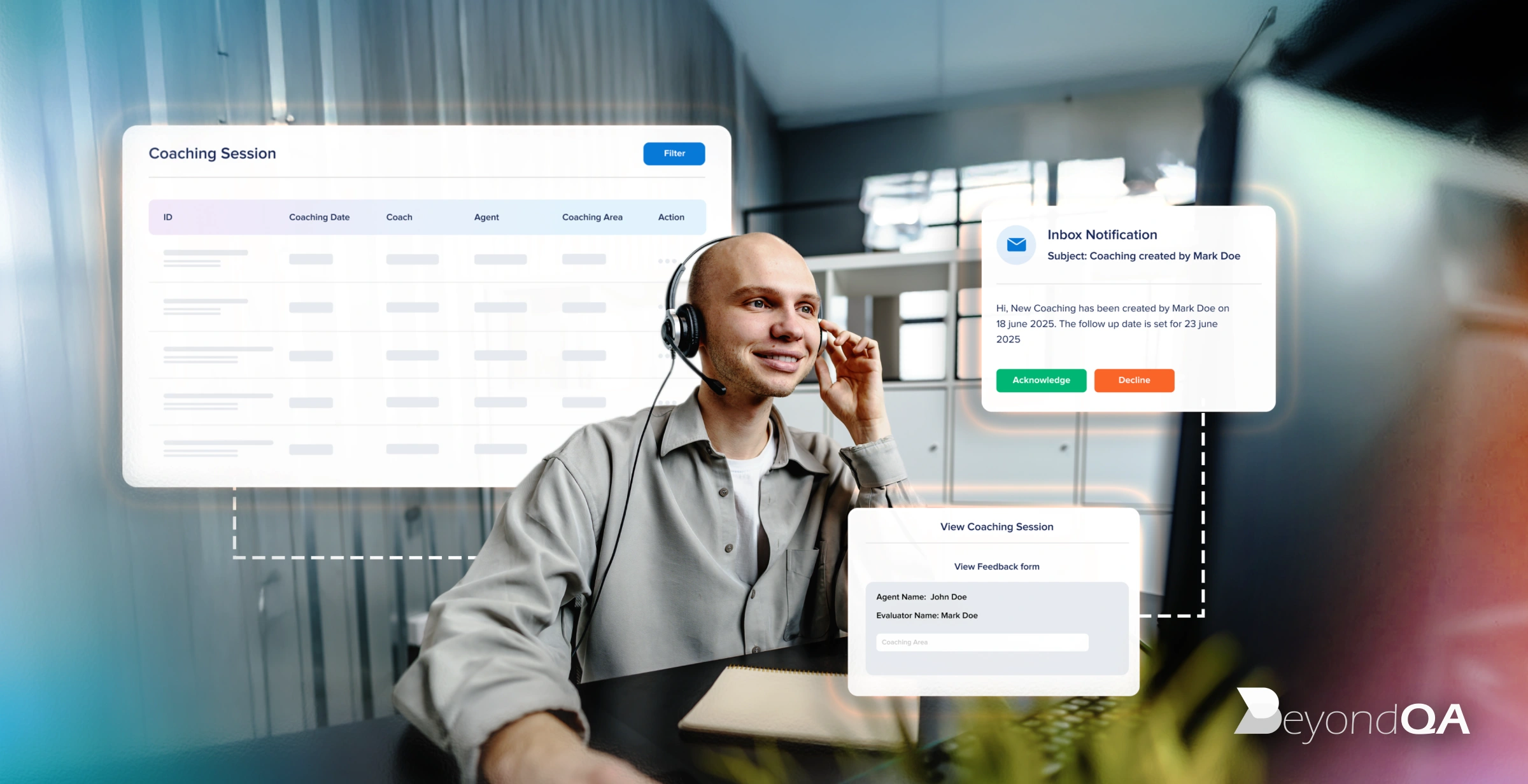In this blog, we’re going to explore the call center productivity metrics insights to go beyond vanity KPIs and learn how modern leaders are resharing customer experience.
10 Essential Call Center Productivity Metrics
Here, you can find the top 10 call center productivity metrics, effectively helping curate frictionless workflows, driven retention, and reshape performance models.
Average Handle Time (AHT)
Customers interactions must be quick, and accurate, and AHT helps to measure it. Using the average handle time, contact centers can measures the total time an agent spends on customer interactions. In addition, it covers the end-to-end time frame, including talk, hold, and after-call work.
While outsourcing, enterprise leaders look for low AHT, which is correct. However, quality should not be overlooked, otherwise customer dissatisfaction on the way.
Formula: AHT = (Talk Time + Hold Time + After-Call Work Time) / Total Number of Calls
First Call Resolution (FCR)
First call resolution is a key CX and cost-efficiency driver. High FCR means fewer callbacks, and low handling costs, which makes it a highly considerable call center productivity metric. To improve FCR, an enterprise can consider the following best practices:
- Centralize the customer in a unified CRM for data-driven insights
- Use analytics to identify and optimize repeat call patterns
- Train agents on end-to-end resolutions skills
- Implement AI-enabled IVR routing to skilled agents
Formula: Occupancy Rate = (Total Time on Calls + After-Call Work) / Total Logged-In Time × 100
Adherence to Schedule
Schedule adherence help contact centers to understand how closely agents are following their assigned shifts. Under the umbrella of adherence to schedule metric, service levels, staffing, efficiency, and cost management, all get covered.
Moreover, it’s an essential contact center productivity metrics, as poor adherence can create coverage gaps, and increase wait time. But, you can always optimize it by using self-service schedule management, and shift bidding systems.
Formula: Schedule Adherence = (Time on Shift – Time Out of Adherence) / Time on Shift × 100
Service Level (SL%)
Every contact center prioritize service level, as it helps to measure the number of calls answered within a specific timeframe. Most of the CX outsourcing firms consider the 80% of calls answered in 20 seconds industry benchmark. It’s a crucial CX metric, but solely focusing on this can degrade quality.
Further, to improve SL%, introduce skill-based AI call routing, utilize historical data for forecasting, apply dynamic staffing, and use IVR for low-complexity issues.
Formula: SL% = (Calls Answered Within Threshold / Total Incoming Calls) × 100
Call Abandonment Rate
If a contact center has a high call abundant rate, there’s a serious issue in their workflow. The call abandonment rate indicates the callers who disconnect before reaching out to an agent. And, this cause customer trust eroding, and low first-call resolution rate.
This metric is vital and to improve it:
- Implement queue callback options
- Reduce wait times with better staffing forecasts
- Use IVR menus to route calls efficiently
- Monitor abandonment by channel and time
Formula: Abandonment Rate = (Abandoned Calls / Total Incoming Calls) × 100
Customer Satisfaction Score (CSAT)
In the CX ecosystem, customer satisfaction score ranks at the top. It’s one of the most significant contact center productivity metrics, often collected through post-call surveys. While CSAT is subjective, tracking it over time helps executives to identify system CX gaps and align delivery with expectations.

- Prioritize personalization across all communication channels
- Train agents on empathy and emotional intelligence
- Analyze low CSAT drives by agent or issue
- Close the feedback loop with real-time coaching
Formula: CSAT = (Number of Satisfied Responses / Total Survey Responses) × 100
Agent Turnover/Attrition Rate
Agent turnover rate reflects the frequency of agents leaving the organization. A higher agent attrition rate means high cost getting invested in recruitment, instead of curating strategic customer experiences. As a contact center, reducing turnover must be a priority task, which should get executed through:
- Prioritizing employee experience (EX) similar to customer experience (CX)
- Conducting exit interviews to uncover root cause
- Providing mental wellness and burnout prevention programs
- Creating recognition and performance-based incentives
Formula: Turnover Rate = (Agents Who Left / Average Number of Agents) × 100
After Call Work Time (ACW)
Nowadays, ACW is a must-to-consider contact center productivity metric. It refers to the post-interactions tasks agents complete, including note taking, follow-ups, and CRM updates. Excessive ACW reduces available handling time, and may indicate process friction.
To improve after call work time at your call center, you should automate call logging, utilize CRM templates, minimize documentation requirements, and integrate call wrap-up tools.
Formula: ACW Time = Total After-Call Work Time / Total Number of Calls
Quality Assurance (QA) Score
QA score helps to evaluate agent’s performance on custom defined metrics, such as compliance, tone, and accuracy. It’s a vital control mechanism to maintain consistency, brand reputation, and risk management. Nowadays, scoring agent has evolved from a subjective sample to AI-driven insights.
You must focus on maintaining the CX quality through:
- BeyondQA implementation across all communication channels
- Utilizing sentiment analysis to assess soft skills
- Aligning QA metrics with business and compliance goals
- Enabling agents to self-score for better reflection
Formula: QA Score = (Points Earned / Total Points Possible) × 100
Advanced Productivity Metrics for Modern Call Centers
These advance contact center productivity metrics go beyond the traditional metrics, focusing on proactive optimization and customer intelligence.
1: Customer Effort Score (CES)
As the name suggests, CES measures how easy it was for a customer to get their issue resolved. Unlike CSAT, CES captures process friction and reveals CX barriers. In 2025, enterprises are utilizing it to redesign customer journeys, reduce wait time, and improve NPS.
You can also improve CES by eliminating friction points, using real-time feedback to optimize self-service channel, and linking CES trends to churn/retention analytics.
Additionally, according to Business Wire, 78% of UK consumers are unlikely to repurchase from retailers after a poor delivery experience.
Formula: CES = Sum of All CES Survey Scores / Total Number of Responses
2: Agent Assist Adoption Rate
This metric is now trending, as the use of AI tools is increasing. It helps to assess how often support agents use tools like knowledge bots, guided workflows, and co-pilots. It reflects the training effectiveness, agent reliance, and even AI adoption by a contact center.
With a higher agent assist adoption rate, an enterprise can assure lower handling time, consistent resolution, and scalable CX services.
Formula: Adoption Rate = (Number of Assisted Interactions / Total Eligible Interactions) × 100
3: Predictive Churn Risk Score
To measure predictive churn risk, you need an AI to forecast which customer ate likely to leave based on behavioral, transactional, and sentiment data. Executives are using this contact center metric to route high-risk customers to expert agents, personalize offers, and engage in-time sensitive interventions before revenue is lost.
To improve the predictive churn risk rate, your contact center should:
- Integrate voice/sentiment analytics with CRM
- Automate targeted win-back campaigns
- Adjust scoring weights based on historical attrition
- Correlate churn risk with product or service feedback
Formula: Churn Risk Score = Weighted AI Model Output (based on interaction history, issue type, satisfaction, sentiment, etc.)
How BeyondQA Improves Call Center Productivity Metrics
From AHT to QA score, BeyondQA is purpose-built to optimize all the call center productivity metrics that matter most to modern contact centers. This AI-powered quality assurance platform automatically analyzes 100% of omnichannel interactions, helping to:
- Reduce handle time
- Increase first call resolution rate
- Improve service consistency
- Reduce manual QA efforts
Additionally, it delivers real-time feedback and sentimental insights, which enables supervisors to efficiently coach agents. As a result, contact centers reduce after-call work, improve occupancy rate, and optimize CSAT and CES by surfacing high-effort journeys and emotional triggers.
Furthermore, BeyondQA provides a performance dashboard, leading call centers to improve adherence, cut agent churn, and ensure quality even during surge periods. Therefore, whether you’re focused on reducing abandonment rate, or elevating FCR, BeyondQA helps you transform every call center productivity metric into measurable outcomes.
Conclusion: Your Metrics Should Tell a Business Story
For CX leaders, and operations heads, contact center productivity metrics are no longer about just to improve KPIs. They are about to ensure those KPIs lead towards revenue protection, brand equity, and cost transformation.
And the winning formula to achieve such goal is to focus on all essential metrics and optimize them per requirements, and evolving trends. Your modern call center can only thrive, if you’re focusing not only achieving industry benchmarks, but working on going beyond them.
Shift From Manual QA to Machine Precision
Automate your call quality process and gain actionable
insights within minutes, not days.




